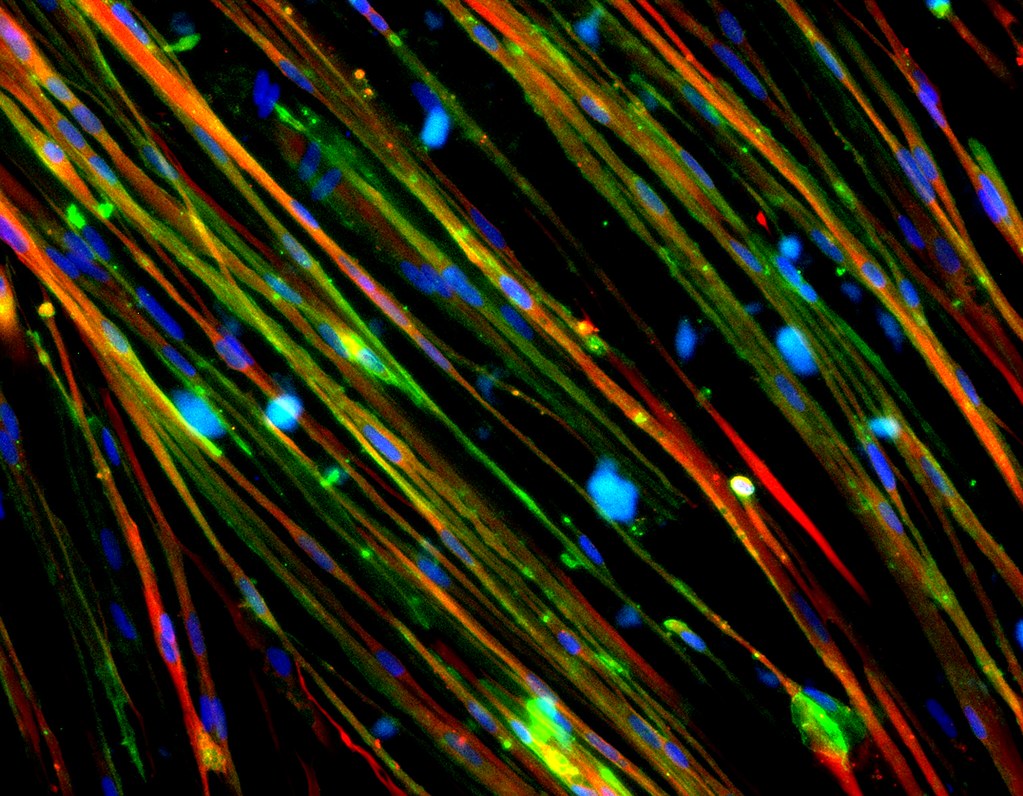
Duchenne muscular dystrophy (DMD) is a rare progressive genetic disease that affects 1 in 5,000 males. The condition can result from a variety of possible errors (gene deletions, duplications, point mutations or premature stop codons) that affect expression of the gene for dystrophin, a protein that stabilizes muscle cell membranes and supports the ability of muscle to contract. Without functional dystrophin, muscle damage progressively accumulates, leading to scarring, inflammation, and eventual muscle atrophy. Affected boys typically begin to show symptoms around age four. By the time most patients are 12 years old, they require a wheelchair, and during adolescence, heart and breathing muscles progressively weaken. Death typically results in the fourth decade of life, as a result of pulmonary and cardiac complications.
Because DMD is associated with mutations in the gene for a single protein, and because muscle cells do not divide and are long-living, the disease has long been considered a good candidate for a one-time gene therapy with potentially life-long benefits. However, developing an effective gene therapy has been challenging. The full-length dystrophin gene is too large to be delivered directly. As a result, the most promising approaches have been based on the delivery of small genetic constructs that circumvent errors in the dystrophin gene, and which typically results in a shortened dystrophin molecule with optimized protein function.
Four companies are currently conducting clinical trials of various gene therapies for DMD: Sarepta Therapeutics, Pfizer, and Solid Biosciences in the United States, and Genethon in collaboration with Sarepta in Europe. While their approaches employ different transgene sequences, the delivery of the genetic constructs is accomplished in each case using an adeno-associated virus (AAV) vector, with slight variations in the method of vector administration between therapeutics.
Unfortunately, a similar serious adverse event has been reported in at least five patients across three different DMD trials (a total of 161 patients): an unusual, accelerated muscle weakness with variable cardiac involvement. In each case, symptoms (including speech and swallowing difficulties) first appeared 24-42 days after administration of the gene therapy, a time point by which key muscle building proteins would be stimulated. Each of the affected patients regained their muscle strength and normalized cardiac enzyme levels after treatment with immunosuppressive and supportive therapies. However, such serious adverse events slowed the pace of research, as clinical studies were temporarily halted to look at the problem.
Because the adverse event risk appeared to be common across the DMD gene therapy programs, Pfizer, Sarepta, Solid Biosciences, and Genethon collaborated to understand the issue and its possible cause, with the aim of minimizing further occurrences in their respective DMD development programs. They shared clinical and laboratory data, and assembled a panel of experts in neuromuscular disease, inflammation, genetics, and cardiac disease to try to discern a reason for the problem. The collaborating companies and panel chairs presented their initial pooled safety analysis at the American Society of Gene and Cell Therapy meeting in May 2022.
The analysis suggests that the adverse event is related to a T cell-mediated inflammatory response to the delivered DMD transgene, although the effect does not appear to be specific to any particular DNA sequences in the companies’ various transgenes. Instead, the risk of the event appears to be related to the patient’s genotype, as the severe adverse events were found to occur only in patients with certain genomic deletions. Further understanding of the mechanism behind the adverse event has not yet been elucidated.
Based on these findings, each company has adjusted their studies to exclude the enrollment of DMD patients with the suspect mutations from their trials. Meanwhile, the joint safety investigation continues to study and define the immune mechanism behind the adverse events and any other risk factors, with the aim of informing future gene therapy studies in DMD and beyond.